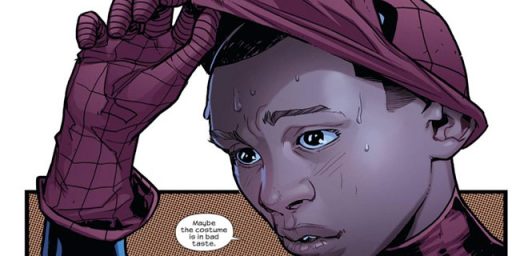Green Arrow Gets HIV-Positive Sidekick
Comic Book Superhero Gets HIV-Positive Sidekick (Local 6 – AP)
long with fighting alien menaces and criminal masterminds, the “Green Arrow” comic book will now feature a sidekick engaged in a more personal struggle – this one against HIV. It’s the first major comic book to deal with HIV, and a dose of hard-edged reality to the usually fanciful world of costumed crime fighters. In the latest issue of “Green Arrow,” published Wednesday, a teenage runaway named Mia — who has been in the care of the title hero for two years — discovers that her time spent as a street-dweller and prostitute has resulted in her picking up the virus.
Writer Judd Winick, who oversees the “Green Arrow” story line, said this is a way to explore socially conscious themes while also giving the Mia character extra motivation to make a difference in the world. “We’ve been hinting all along the way that she’s interested in taking up the mantle, being a sidekick, getting out there in the streets and helping out,” Winick told The Associated Press. “Green Arrow won’t hear of it.”
The news that she has HIV leads her to push Green Arrow even more. Fighting crime, Winick said, is what she wants to do with her life. “So he allows her to slap on a costume and become his sidekick, which has the silly name of Speedy,” Winick said. “It’s not as a death wish, but she can’t fool around anymore. This isn’t about an abbreviated life span. It is about life having focus,” he added.Speedy was originally a boy sidekick, but the character is now grown up and goes by the more mature name of Arsenal.
Winick may be known to some from his stint on MTV’s roommate reality-show, “The Real World” 1993, on which he appeared with Pedro Zamora, who died the next year after a public battle with AIDS. That experience, along with other friends who have contracted the virus, made the Mia story line a personal one for the writer. He said he wanted to approach HIV from the point of view of other young people. “Mia is coming to terms with it in the way most young people are. It isn’t about death and dying. Young people, for good or for bad, are still pretty fearless. With drug combination therapy people are living a very long time,” Winick told the AP. “She seems to be unafraid of death, she’s mostly feeling like no one is ever going to love her. She’s HIV-positive and who’s going to want to be with her now?”
Mia won’t be lonely for long. As Speedy, she will later join the popular “Teen Titans” DC Comics series alongside Robin, Cyborg and Raven in the popular youth hero series.
Although some may perceive the HIV story line as a downer, Winick said it’s important for comics to address real-world matters. “Comics have a long history of telling lessons,” he said. “They tell stories through metaphor, but sometimes I feel we don’t need the metaphor. Why should it be that Mia contracts some alien virus?”
Comics have been dealing with social issues since at least the late 1960s. Indeed, somewhat ironically, some classic Green Arrow-Green Lantern stories of the early 1970s risked running afoul of the Comics Code Authority by showing the original Speedy addicted to heroin. Later in the decade, the alter ego of Marvel’s Iron Man battled alcoholism and characters from The Avengers went through a bitter divorce.






Mixed feelings on this one. It’s definitely not Mike Grell* anymore. OTOH Green Arrow can be an inherently earthy crunchy character, and a good vehicle for this sort of thing.
I have long had the notion that Green Arrow could be done as a film with success, and had the beginnings of a plot in mind circa late eighties.
* Hoping I remember his name correctly.
Does “The Ambiguously Gay Duo” count? They’ve been dealing with “issues” from day one …
Isn’t the lesson here clearly that one oughtn’t hang out with Green Arrow?
Educating our children responsibly about such grave issues is a good thing. Emphasis on the word “responsibly”. It will be interesting to see the message being sent, and if there are any agendas.
A real detriment to the AIDS cause, there is usually some “superhuman” agenda behind the scene. I don’t want media, a teacher, or anybody else soapboxing to my kids (if that’s what it is). We need to be very careful about how adult issues are conveyed to minors.
Ultimately that falls on the household. Unfortunately, we have too many households with no parental control. AND too much media, and activists, with big mouths.
I don’t like this.
I’ve never liked the character of Mia, but I still don’t like this. There are genuine health hazards — to other people — involved in being HIV+ and in combat, and “combat” most definitely describes what superheroes like Green Arrow do.
How many times have street-level characters like her been wounded, shot, stabbed, etc? How many times have they had to go back into the burning building to carry out survivors anyway? Heck, in the current Green Arrow run alone, the reason Mia was in the doctor’s office in the first place was to get stitched up.
Kee-ripes, there’s a scene where Connor Hawke (Green Arrow’s son) deliberately shoots an arrow /through her shoulder/ to nail a hostage-taker standing on the other side.
The message you should send HIV+ people is /not/ “It’s OK to go out and be in a job where you routinely bleed on other people, and anybody who tells you otherwise is just tryin’ to put you down.” And yet, having an HIV+ superheroine does just that.